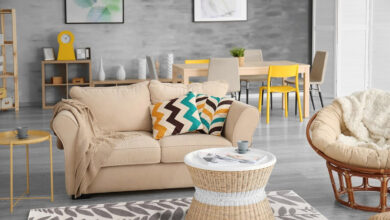
3 Ways to Soundproof a Room Without Breaking Any Walls
- 1 - Put Up Soundproofing Curtains or Blankets
- 2 - Hang Acoustic Fabric or Foam Panels
- 3 - Install Acoustic Wood Wall Panels
Nobody likes noisy neighbours – there’s no doubt about that!
Soundproofing your space can help cut down on extra noise, preventing sounds from coming in or getting out.
However, if you live in a flat or house that’s already built, soundproofing poses an extra challenge. You can’t tear down any walls or do major construction, so how do you soundproof a bedroom, living room, or kitchen?
To increase a room’s sound absorption without breaking the bank – or the walls – you have three simple solutions: putting up soundproofing curtains or blankets, hanging acoustic fabric or foam panels, or installing acoustic wood wall panels.
Read up on the individual solutions below:
1 – Put Up Soundproofing Curtains or Blankets
If you want a minimum-impact soundproofing solution, you can use items like curtains or blankets designed for sound absorption.
Soundproofing blankets are made of thick, absorptive materials that block or reflect sound. In general, you should look for a sound blocking blanket rather than a sound-absorbing blanket. The sound blocking style is heavier, with a mass loaded vinyl core.
Whether you choose blocking or absorbing, you should ensure your soundproof blanket has an STC rating. This rating verifies that the blanket has been lab- and field-tested. You can easily hang soundproof blankets on the walls with nails, screws, or thumbtacks.
Soundproof curtains are also an option for a finished room. They’re better at deadening sound rather than completely blocking it. But if you have little noise pollution, then a sound deadener might be just what you need.
Curtains are also a more attractive option than blankets, which tend to look utilitarian. You can found sound-deadening curtains in a variety of colours and styles so they’ll match your home’s aesthetic. To reduce sound, the curtains are made of dense fabric, with a porous exterior lining to absorb sound waves.
The best way to install them for maximum sound absorption is from floor to ceiling, with a ceiling mount rather than a wall mount. Also, if you’re putting the curtains over a window, double the panels you’ll need to create even more density.
2 – Hang Acoustic Fabric or Foam Panels
Hanging acoustic panels on your walls is another cost-effective sound reduction solution that won’t cause any damage or require construction.
Fabric panels can be easily installed and removed, so they’re perfect for renters or homeowners planning to move out soon.
The panels are constructed with acoustic materials and then covered in fabric. The fabric’s main purpose is aesthetic, but it also has sound-absorbing properties you should consider. Look for a polyester or polypropylene material because these perform better on vertical surfaces. Fabric panels also help with internal noise reduction, which is why they’re often used in commercial spaces like cinemas.
If you want panels that absorb more sound than fabric panels, then try foam instead.
Foam panels are used in recording studios to trap sound in the room. They’re less attractive than fabric panels, but they do come in a variety of colours. Foam panels also range in thickness, from a couple of centimeters to 30 centimeters thick, and you can choose which size you need.
To install foam panels, there’s no need to put up more drywall or even use nails and screws. You simply need a special adhesive to attach the panels to your walls. With their noise reduction and acoustic properties, foam panels are perfect for living rooms with TVs or entertainment centres.
3 – Install Acoustic Wood Wall Panels
If you like the idea of acoustic panels but don’t want fabric or foam, then you can install acoustic wood wall panels instead.
Timber wall panels are more stylish and versatile than fabric or foam.
Aesthetically speaking, you wouldn’t want to put fabric or foam panels in a kitchen or bathroom, for instance. But you might still need soundproofing materials for these rooms. Wood-slat panelling fits neatly into any room, coming in different colours and finishes, so to make for a stunning feature wall.
But how does wood wall cladding reduce sound? Panels like Acupanel from the Wood Veneer Hub have sound-absorbing felt backing. The panels have an absorption coefficient of 0.97 at a frequency of 1,000 Hz. They’re made entirely of sustainable materials, reduce noise and sound reverberation, and are easy to install.
If you want to maximize sound absorption, you can fix them onto your wall or ceiling with batons. A more decorative option is screwing through the felt backing, directly into the wall.
Wood slat panelling with sound-absorbing properties is the perfect aesthetic option for no-damage soundproofing.
Final Thoughts
There are so many ways to soundproof a room, you can easily find a solution that works for your home.
If you don’t want to break or build any walls, then curtains, blankets, and panels in fabric, foam, or wood slat can help you reduce noise.
And if you want the most attractive option, then go for wood wall panelling with acoustic properties.






